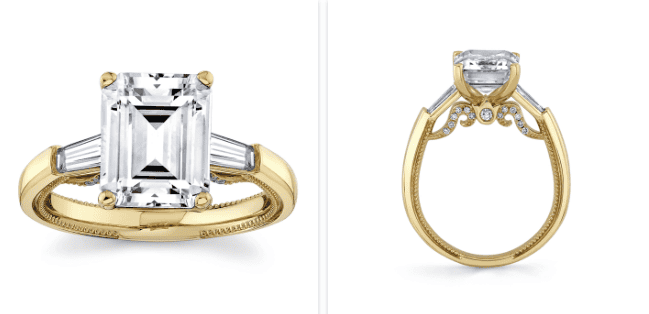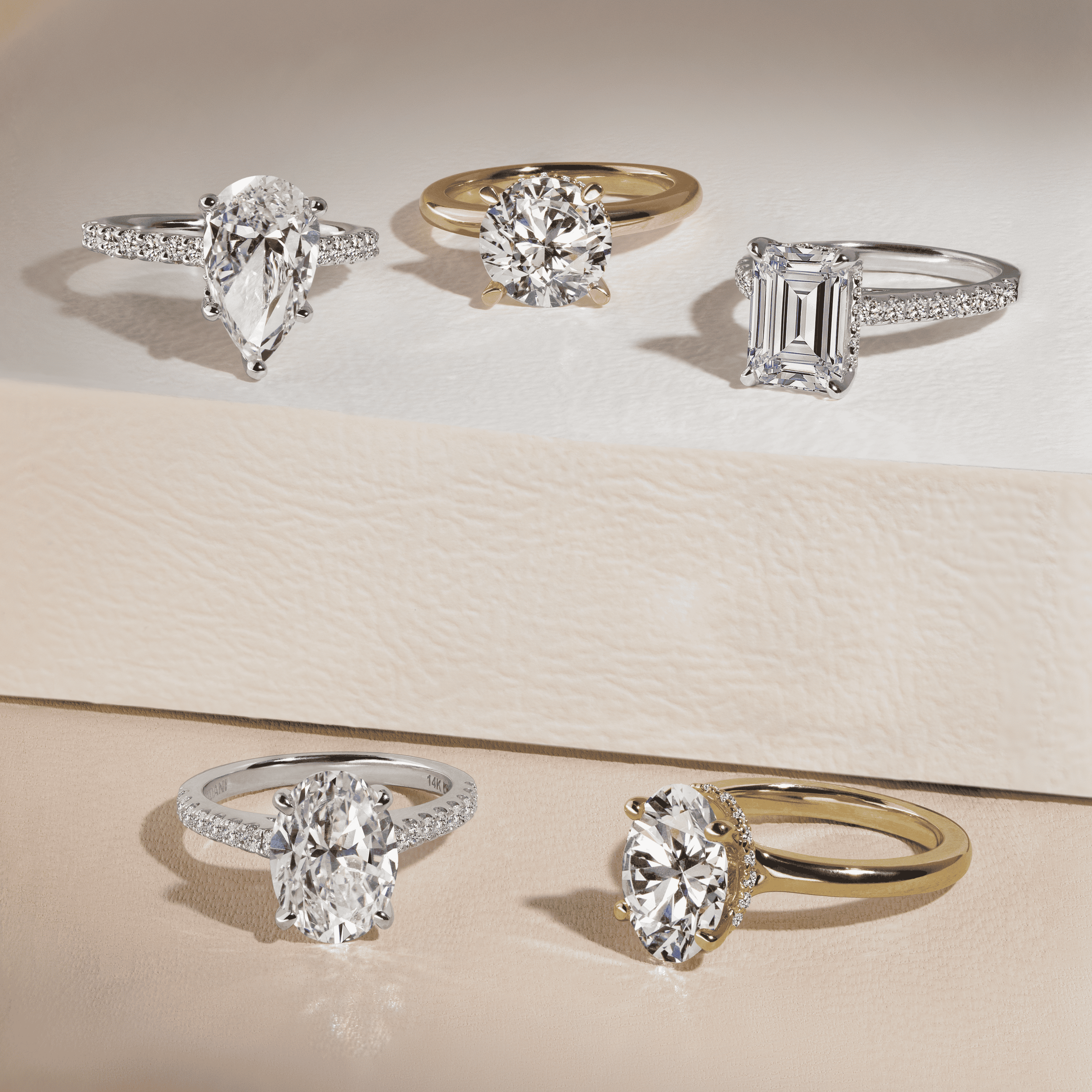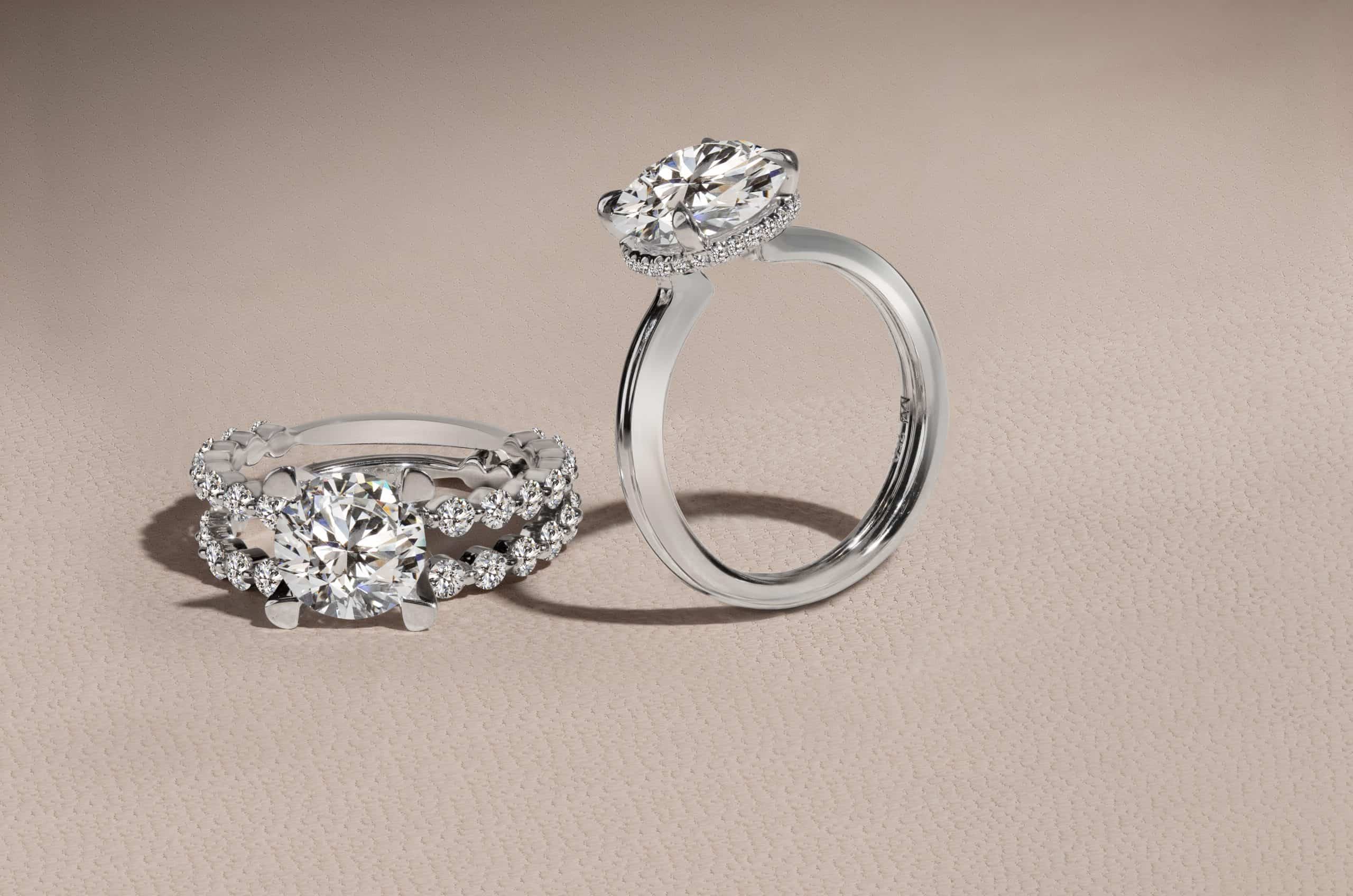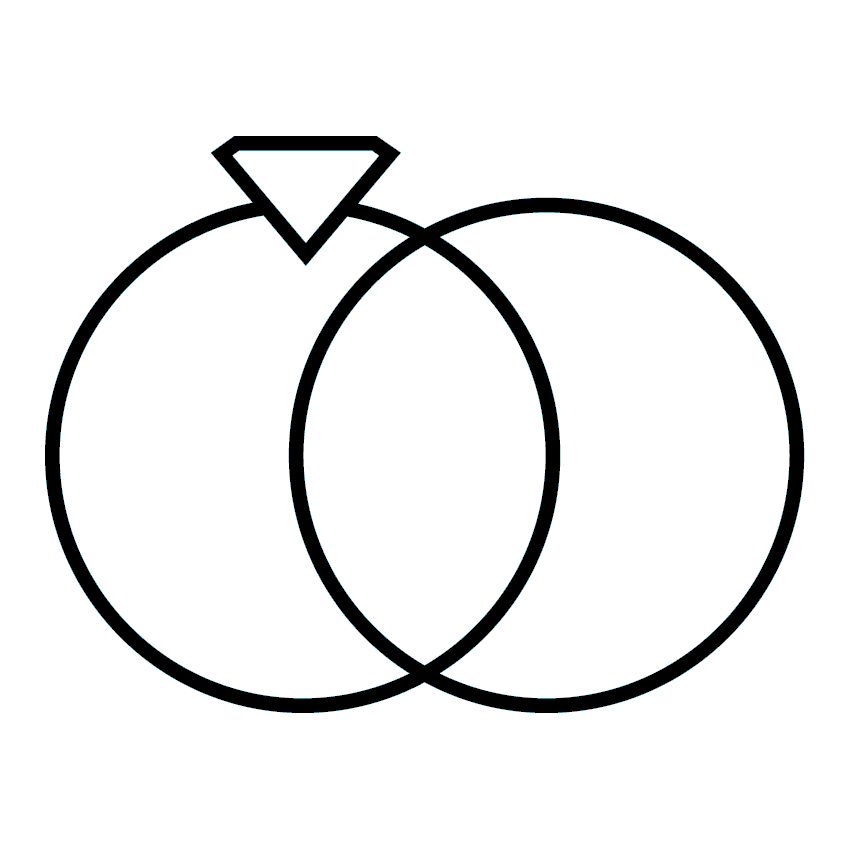When you start shopping for an engagement ring, you might wonder how much you should spend. Maybe you’ve heard you should spend two months salary, but that can seem rather arbitrary. How can you determine what your ring shopping budget should be?
How much you spend is a personal decision – there’s not one “right” answer. Your budget is based on so many individual factors and what you prioritize. Don’t let anyone talk you into spending more than you’re comfortable with. If you prefer not to outlay cash, you can look into financing. We offer easy financing options and you can pre-quality online before you start shopping.
You might still be looking for guidance on what to expect. Here are some questions to ask yourself to gather knowledge and information about what’s important to you.
What’s Your Ring Style?
An engagement cost is comprised of two elements:
You can select the setting and the center diamond separately. If you prefer a minimalist solitaire (that consists of a simple band and center stone), your setting price will often be less than if you prefer a setting that includes elements such as a pavé diamond band and sidestones.
For instance, these minimal solitaire settings maximize focus on the brilliant center diamond:
0456078 0455850 0455851 0457300
The settings below feature details such as pavé diamond bands, hidden design details, and diamond halos surrounding the center diamond:
0460340 0460346 0460350 0460343 0460347 0460342 0460341
Below is a closer look at some of these details:
| Intricate details and diamonds hidden in a side view | Halo surrounding center stone and pavé diamond band | Round and east/west emerald diamond band | Hidden halo |
Which Metal Do You Prefer?
The most common metal options you’ll find for engagement rings are white or yellow gold and platinum. If you choose gold, you can select 14k or 18k. All of these choices are beautiful and long-lasting. Below is more about each option, from most affordable to most expensive:
- 14k gold – Pure gold is too soft to be used for jewelry, so it is blended with other metals to strengthen it. 14k gold (14 of 24 parts or 58%) has less pure gold than 18k so is less expensive and more durable. 14k gold is a great choice if you’re concerned about scratches or you are looking to maximize your budget.
0451471 0444469 0451469 0451470 0451466
- 18k gold – 18k gold (18 of 24 parts or 75%) has more gold and fewer other metals than 14k. It can be more prone to scratches and is more expensive than 14k gold since its gold composition is higher. 18k is a good choice if your skin is easily irritated by metals since it has a lower composition of metals other than gold.

- Platinum – Platinum looks similar to white gold but is naturally white so doesn’t have a plating. Platinum is also 60% denser than gold. These characteristics mean that platinum is lower maintenance. It won’t fade or lose color over time and doesn’t require re-plating. Since platinum doesn’t contain a mix of metals, it’s hypo-allergenic (gold can contain alloys such as nickel, which some are allergic to). If you need a hypo-allergenic metal, or prioritize lower maintenance, platinum may be a good choice. Platinum is 30 times rarer than gold so is generally more expensive.
0456569 0388111 0413026 0413022 0456570 0452493 0388101 0388102
Which Gold Color Do You Prefer?
If you choose gold, your options are yellow, white, or rose and pricing is generally the same (although white gold can be slightly more expensive depending on the metal mix). All three are available in 14k and 18k. Both yellow and rose gold include a mix of copper and silver but rose gold contains a higher amount of copper to give it a slight pink glow. White gold often has a mix of copper, zinc, nickel and palladium and is plated with rhodium. (This plating can be redone if the ring dulls or scratches over time.)
0429234 0429237 0429228 0429230 0429220 0429224 0452919 0452918
What’s Your Ideal Center Diamond Size and Quality?
Diamonds are evaluated according to the 4Cs: cut, color, clarity, and carats. Some people think that a diamond’s price is based on its size (or carat weight) but actually all four attributes work together. For the same price, you might prefer a smaller carat size but higher clarity (or the reverse). This is why it’s so important to evaluate diamonds in person since not everyone values the same criteria. (When you come into a Robbins Brothers store, you can evaluate diamonds in our diamond viewing room with a laboratory light and 10x magnification microscope)
- Cut – is how the diamond has been shaped and faceted from its initial form. A well proportioned and symmetrical cut results in a diamond that maximizes sparkle, brilliance, and scintillation. Diamond cuts are graded as excellent, very good, good, fair, and poor. A well-cut diamond with a lower clarity or color can look more stunning and sparkling than a poorly-cut diamond with higher clarity or color because of its superior ability to reflect and refract light.
- Color – ranges from icy white colorless to light yellow. The color can be difficult to compare without looking at diamonds side by side. The more colorless, the more rare and thus more expensive. However, unlike cut, more expensive is not necessarily “better” as the diamond color depends on personal preference of a cooler or warmer tone.
- Clarity – refers to the tiny inclusions (markings and imperfections) in the diamond. The GIA diamond grading scale is used to grade diamonds from flawless (most rare and most expensive) to included 3 (least rare and least expensive). Diamonds graded as “included” (I1, I2, or I3) have inclusions that are visible to the naked eye. Those graded as “slightly included” (SI1 or SI2) have minor inclusions that are noticeable under 10x magnification and might be visible to the naked eye (depending on the inclusions). Diamonds graded higher (very slightly included: VS1 or VS2 or very, very slightly included: VVS1 or VVS2) are typically not visible to the naked eye and for very, very slightly included may be difficult to see under magnification.
- Carat weight – 1 carat is divided into 100 points (so 50 points is ½ carat weight). Some people are looking for the largest diamond that fits their budget but the price and value are based on a combination of carat weight and other factors (cut, color, and clarity). The cut, for instance, can determine how sparkling a diamond is. In addition, the diamond shape influences how large a diamond looks (an oval may appear larger than a round diamond, for example). The ring setting also plays a part in how large the center stone looks. For example, a halo setting can amplify the center stone size.
What Diamond Shape Do You Prefer?
You can choose a center stone in a number of shapes. Some ring settings are intended for a particular shape, whereas others can work well with many different shapes. Cost can vary by diamond shape since not all shapes use the same percentage of the original diamond and some shapes require more time and attention to create.
Round brilliant diamonds, for instance, result in more waste. Also, since round diamonds have the highest number of facets (58), they require precise craftsmanship for optimal sparkle. Other shapes, such as emerald, also require precise facet alignment and can take more time to cut. (This is one reason loose diamonds with the same specifications but different shapes may vary in price.)
Also, consider that round brilliant diamonds may appear smaller than an elongated shape such as an oval or marquise so you may tend to look for a round diamond with a higher carat weight to appear to be similarly sized to an elongated diamond shape. Learn more about diamond shapes:
Do You Prefer Natural or Lab-Grown Diamonds?
Both natural and lab-grown diamonds are authentic diamonds and have the same chemical composition.
Natural diamonds are rare gems, created from billions of years of pressure and heat from the earth’s core. They epitomize the beautiful tradition of diamonds as representation of your everlasting bond and love. Due to their rarity, natural diamonds are more expensive than lab-grown diamonds. If the tradition and symbolism of diamonds is a key priority, you may prefer a natural diamond. Also, if you might want to “trade-up” your diamond at a later date (perhaps for an anniversary), a natural diamond is a great choice, as you can take advantage of our 110% natural diamond trade-up guarantee.
Lab-grown diamonds combine the timeless beauty of diamonds with modern sensibilities. Since lab-grown diamonds are more affordable than natural diamonds, you can get more diamond for your budget (“more” could mean a larger carat weight or higher quality as measured by the color and clarity.) If maximizing your budget is your priority or you’re more modern than traditional, a lab-grown diamond might be the diamond for you.
How Do All of These Choices Impact Your Budget?
Hopefully, you now have a better idea of why engagement ring pricing can vary so much and what to look for as you compare. You can browse our selection online to get a general idea of pricing and then stop into one of our stores anytime to browse our full selection of engagement ring settings and loose diamonds. We’re always happy to answer questions and show you all of the options that are available.
For an idea of ring setting pricing, take a look at some of our online options:
- Solitaire settings
- Halo design settings
- Pavé band settings
- Milgrain detail settings
- 14k yellow gold settings
- 18k white gold settings
- Platinum settings
And for a general idea of center diamond pricing, browse our loose diamonds. You can select:
- natural/mined or lab-grown
- diamond shape
- carat weight range
- cut range
- color range
- clarity range
- price range
When browsing the engagement ring settings, scroll to the details section and expand the “center stone information” to determine if the ring setting is designed for a particular ring shape. (If you know the diamond shape you are looking for, you can filter the ring settings by choosing the shape from the available options.
For example, this Michael M 18k white gold natural diamond engagement ring setting has 2 ¼ carats of diamonds (primarily in the band sidestones). It also has hidden elements such as a hidden halo. The sidestone diamond quality is G, VS2 (near colorless, very slightly included). (Click the link for the latest pricing.)
The setting is designed for an emerald cut diamond shape. An example of a natural diamond with similar quality (H, VS2) with a 1.20 carat weight is shown below:
This 14k yellow gold solitaire engagement ring setting is a minimal style and is more affordably priced. (Click the link for the latest pricing.)
The setting is designed for an oval diamond shape. An example of a lab-grown diamond with similar size and quality as the natural emerald-cut diamond (G, VS1, 1.25 carat weight) is shown below:
As you can see, there’s not a set price range for engagement rings and the cost is dependent on what is most important to you — not a particular number. Stop into your local Robbins Brothers today to find your perfect ring.
- Holiday Jewelry Gift Guide for Mom - December 3, 2025
- What are Lab Grown Diamonds? Why They Might Be the Perfect Choice for Your Engagement and Wedding Rings - December 2, 2025
- Holiday Jewelry Gift Guide For Her - November 26, 2025


